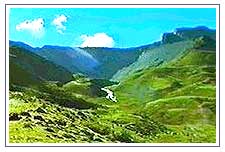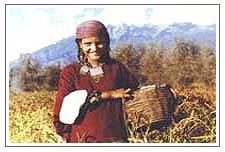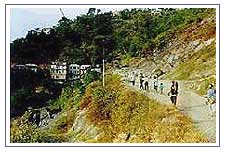
The
Himalaya, roof of the world, is a magic place where the magnificence of
the world's highest mountains is mirrored in the rugged beauty and
unique culture of the people who live in their shadow.
Duration: 06 Nights - 07 Days
Duration: 07 Nights - 08 Days
Duration: 08 Nights - 09 Days
Duration: 09 Nights - 10 Days
Duration: 11 Nights - 12 Days
Duration: 05 Nights - 06 Days
North Eastern India Himalaya States
| Location: |
North Eastern Part Of
India |
| Region's Major States: |
|
| Best Time To Visit: |
October To March |
|
Click Here for
Indian Himalayan Tours |
Adventure in
Seven Sisters
|
|
Travel across the Brahmaputra and reach the land where myth meets magic and
wishes are horses! The land where nature endows man and is yet to be trimmed
and pruned to represent a synthetic civilisation. This land is better known
to the worth as the North-Eastern region of India, that comprise of seven
states called the "Seven Sisters" - Assam, Nagaland, Tripura,
Meghalaya, Manipur, Mizoram and Arunachal Pradesh.
The region of northeastern India will whet the appetite of the traveller,
the tourist, the anthropologist, the observer. It is impossible to describe
the nuances that make this area unique, challenging and interesting. Get to
any one place and the result will be that you will return for more.

Assam
possibly has more folklore and tradition than any other place in India.
There are archaeological ruins all over Assam but the ones around Sibsagar
simply must be seen. The largest river island of the world, Manjuli, is a
must too along with Kaziranga wildlife sanctuary. Crossing the magnificent
Brahmaputra so deeply linked to life in Assam, one reaches Guwahati, the
capital where the famous Kamakahya temple is located on a hilltop. Guwahati
has evolved into a major business centre and most of the travel linkages
pass through it.
Travelling in the northeast will take one criss-crossing Assam so one gets
to see many places. If one is travelling at the time of any of the festivals
like Rongali Bihu, then the charm of Assamese culture will permeate your
very being with its rhythm, colour and bonhomie. The dark green tea gardens
blend beautifully with the pastel green of paddy. Digboi, Duliajan and areas
around have oil wells.
Because of
the remoteness, the state of Arunachal has not been overtaken by urban
ethos. Yet the fine balance between advancement and keeping in touch with
ones roots is nowhere as clearly manifest as in this state. Most of
Arunachal Pradesh has primary jungles, deep gorges and villages in really
remote places. The changing colours provide a constant reminder of diversity
and cheerful spirits.
Cane bridges, swaying precariously over roaring white waters we often the
only means of moving from one place to another. Itanagar is the capital of
Arunachal Pradesh. One can travel along National Highway 52 and keep
branching off to visit places like Ziro, Daporijo, Along and Pasighat.

Inhabited
by swarthy tribes, Nagaland has its own distinct culture and ethos. Happy
and cheerful, the people have an innate sense of music and colour. All the
land here is basically owned by villages and individuals and this is true of
many areas of the North-East and, therefore, one rarely hears of land
disputes and clashes.
Gateways to villages and houses are really something to see. Nagaland grows
a fair amount of oranges and pineapples. The all-prevalent green continues
and the scenic beauty of the state overwhelms us. Christianity has had a
profound influence on the region, and one sees well-maintained churches all
over.
Manipur is
somewhat different culturally from the rest of the Northeast region because
of the Vaishnav influence and some of the dance forms are very distinct and
stylised. Along with dance forms, various martial arts are practised here
and the game of Polo is said to have originated in Manipur. Folklores abound
and are supported by a fair amount of recorded history.
The capital city of Imphal itself has a lot to offer - war cemeteries,
Kangla, the building that housed field marshal slim during World War II, the
Orchidarium, many temples and a lot more. One of the more interesting areas
to visit is the Ima Market or Mothers' Market, which is run by women
only.

Tripura
is steeped in history with linkages established from the legendary Limar
dynasty. Recorded history dates back to almost 3,000 years. Even Samudra
Gupta's pillars mention the existence of this state. This is yet
another state like Manipur where Christian influence is negligible. It is
the unique continuous history that has to be absorbed here. In geographical
terms, Tripura is a small state and the second smallest state of India.
The architecture of the temple of Lord Jagannath is interesting and worth
studying. It rises from an octagonal base. The Ujjayant Palace, dating back
to Bir Bikram, is equally interesting with its Indo-Saracenic architecture.
Old buildings and ruins worth exploring are in plenty like the lake palace
called Neer Mahal on Rudrasagar Lake in Udaipur, the ancient capital.
Sipahijala is an interesting area to spend the day. There is a comfortable
guesthouse in the complex surrounded by forests and overlooking a large lake
where one can go boating.
Unlike the
others of the seven sisters, Meghalaya's terrain consists more of
rolling hills and less of steep climbs. There are beautiful meadows with
fringes of pine forests everywhere. As if to complete the picture, there are
breathtaking waterfalls with the waters plunging down hundreds of feet's.
Meghalaya is a unique mixture of the traditional and the modern. People are
fiercely proud of their roots and yet British influence is quite pronounced.
Shillong is the busy hub centre of Meghalaya. The Idew Market or Burra Bazar
is one of the most interesting markets one can ever see over here. For
hours, one can explore the different levels and myriad alleys with shops
displaying a mind-boggling array of items. In and around Shillong itself,
there is lots to do. Visit the butterfly museum or Ward Lake or golf course
or Shillong.
Over the
years, Mizoram has managed to maintain its special touch with Aizawl being
the hub centre. Pollution is low and despite "Jhuming" - a slash
and burn type of cultivation - the greenery is intact. The hills rise
towards the centre of Mizoram therefore Aizawl is pleasant throughout the
year. Lunglei, Champhai and Saiha are the other centres.
Driving along the road, if it is the right season, one comes across plenty
of orchids. If one ventures into the forests, the rewards in terms of
varieties of orchids would be great. The beauty of Mizoram lies in its
unique harmony between man and nature. The clouds come to rest in the
valleys, rainbows abound, small waterfalls gurgle past, greenery is all
encompassing handicrafts are in plenty, the shawls are colourful, the
markets exude cheer. Wherever one turns, a separate type of beauty unfolds
and cheerful and innocent laughter is all pervasive.


 Assam
possibly has more folklore and tradition than any other place in India.
There are archaeological ruins all over Assam but the ones around Sibsagar
simply must be seen. The largest river island of the world, Manjuli, is a
must too along with Kaziranga wildlife sanctuary. Crossing the magnificent
Brahmaputra so deeply linked to life in Assam, one reaches Guwahati, the
capital where the famous Kamakahya temple is located on a hilltop. Guwahati
has evolved into a major business centre and most of the travel linkages
pass through it.
Assam
possibly has more folklore and tradition than any other place in India.
There are archaeological ruins all over Assam but the ones around Sibsagar
simply must be seen. The largest river island of the world, Manjuli, is a
must too along with Kaziranga wildlife sanctuary. Crossing the magnificent
Brahmaputra so deeply linked to life in Assam, one reaches Guwahati, the
capital where the famous Kamakahya temple is located on a hilltop. Guwahati
has evolved into a major business centre and most of the travel linkages
pass through it.  Inhabited
by swarthy tribes, Nagaland has its own distinct culture and ethos. Happy
and cheerful, the people have an innate sense of music and colour. All the
land here is basically owned by villages and individuals and this is true of
many areas of the North-East and, therefore, one rarely hears of land
disputes and clashes.
Inhabited
by swarthy tribes, Nagaland has its own distinct culture and ethos. Happy
and cheerful, the people have an innate sense of music and colour. All the
land here is basically owned by villages and individuals and this is true of
many areas of the North-East and, therefore, one rarely hears of land
disputes and clashes. Tripura
is steeped in history with linkages established from the legendary Limar
dynasty. Recorded history dates back to almost 3,000 years. Even Samudra
Gupta's pillars mention the existence of this state. This is yet
another state like Manipur where Christian influence is negligible. It is
the unique continuous history that has to be absorbed here. In geographical
terms, Tripura is a small state and the second smallest state of India.
Tripura
is steeped in history with linkages established from the legendary Limar
dynasty. Recorded history dates back to almost 3,000 years. Even Samudra
Gupta's pillars mention the existence of this state. This is yet
another state like Manipur where Christian influence is negligible. It is
the unique continuous history that has to be absorbed here. In geographical
terms, Tripura is a small state and the second smallest state of India.